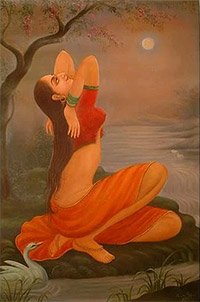Keshamardana, Keśamardana, Kesha-mardana: 4 definitions
Introduction:
Keshamardana means something in Hinduism, Sanskrit. If you want to know the exact meaning, history, etymology or English translation of this term then check out the descriptions on this page. Add your comment or reference to a book if you want to contribute to this summary article.
The Sanskrit term Keśamardana can be transliterated into English as Kesamardana or Keshamardana, using the IAST transliteration scheme (?).
In Hinduism
Kama-shastra (the science of Love-making)
Source: Shodhganga: Elements of Art and Architecture in the Trtiyakhanda of the Visnudharmottarapurana (kama)Keśamardana (केशमर्दन) refers to “pressing hair” and represents one of the “sixty four kinds of Art”, according to the Kāmasūtra of Vātsyāyaṇa.—Indian tradition, basically includes sixty four Art forms are acknowledged. The references of sixty four kinds of kalā are found in the Bhāgavatapurāṇa, Śaiva-Tantras, Kāmasūtra of Vātsyāyaṇa etc.—Cf. “utsādane saṃvāhane keśamardane ca kauśalam”—“proficiency in pressing, shampooing and dressing hair”.

Kamashastra (कामशास्त्र, kāmaśāstra) deals with ancient Indian science of love-making, passion, emotions and other related topics dealing with the pleasures of the senses.
Languages of India and abroad
Sanskrit dictionary
Source: Cologne Digital Sanskrit Dictionaries: Monier-Williams Sanskrit-English DictionaryKeśamardana (केशमर्दन):—[=keśa-mardana] [from keśa] n. cleaning the hair ([varia lectio] -mārjana, one of the 64 kalās) [commentator or commentary] on [Bhāgavata-purāṇa x, 45, 36.]
[Sanskrit to German]
Sanskrit, also spelled संस्कृतम् (saṃskṛtam), is an ancient language of India commonly seen as the grandmother of the Indo-European language family (even English!). Closely allied with Prakrit and Pali, Sanskrit is more exhaustive in both grammar and terms and has the most extensive collection of literature in the world, greatly surpassing its sister-languages Greek and Latin.
See also (Relevant definitions)
Partial matches: Kesa, Mardana.
Full-text: Keshamarjana.
Relevant text
No search results for Keshamardana, Keśamardana, Kesha-mardana, Keśa-mardana, Kesamardana, Kesa-mardana; (plurals include: Keshamardanas, Keśamardanas, mardanas, Kesamardanas) in any book or story.